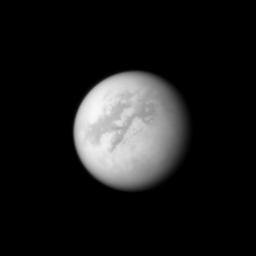
|
Enchanted Titan
- Click the image above for a larger view
- Full-Res JPEG (1500 x 1500) (74.4 kB)
- Full-Res TIFF (1500 x 1500) (2.3 MB)
Caption:
The Cassini spacecraft looks toward Fensal and Aztlan, two dark areas near the equator of Titan.
Like other albedo features on Titan, these areas are named after enchanted places or paradises from legends and myths from the world's cultures. Fensal, the name of the area on the left, is a magnificent mansion in Norse mythology. Aztlan, the name of the dark area on the right of the image, is an Aztec mythical land.
Lit terrain seen here is mostly on the leading hemisphere of Titan (5150 kilometers, or 3200 miles across). North on Titan is up and rotated 38 degrees to the left.
The image was taken with the Cassini spacecraft narrow-angle camera on May 25, 2009 using a spectral filter sensitive to wavelengths of near-infrared light centered at 938 nanometers. The view was acquired at a distance of approximately 1.3 million kilometers (808,000 miles) from Titan and at a Sun-Titan-spacecraft, or phase, angle of 25 degrees. Image scale is 8 kilometers (5 miles) per pixel.
Background Info:
The Cassini-Huygens mission is a cooperative project of NASA, the European Space Agency and the Italian Space Agency. The Jet Propulsion Laboratory, a division of the California Institute of Technology in Pasadena, manages the mission for NASA's Science Mission Directorate, Washington, D.C. The Cassini orbiter and its two onboard cameras were designed, developed and assembled at JPL. The imaging operations center is based at the Space Science Institute in Boulder, Colo.
For more information about the Cassini-Huygens mission visit http://saturn.jpl.nasa.gov/ . The Cassini imaging team homepage is at http://ciclops.org .
Cataloging Keywords:
| Name | Value | Additional Values |
|---|---|---|
| Target | Titan | |
| System | Saturn | |
| Target Type | Satellite | |
| Mission | Cassini-Huygens | |
| Instrument Host | Cassini Orbiter | |
| Host Type | Orbiter | |
| Instrument | Imaging Science Subsystem (ISS) | |
| Detector | Narrow Angle Camera | |
| Extra Keywords | Grayscale, Infrared, Rotation, Visual | |
| Acquisition Date | ||
| Release Date | 2009-07-23 | |
| Date in Caption | 2009-05-25 | |
| Image Credit | NASA/JPL/Space Science Institute | |
| Source | photojournal.jpl.nasa.gov/catalog/PIA11542 | |
| Identifier | PIA11542 | |
